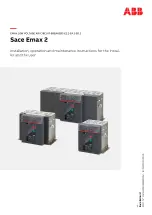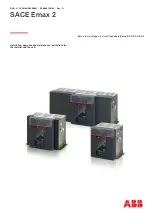
l
PART TWO
I.B. 33-850-1 & 2E
"DB" AIR CIRCUIT BREAKERS
INSTALLATION
Type
"DB"
circuit breakers are furnished as com
plete unit assemblies and the installation consists
of:
(1)
bolting them to the supporting framework
or structure; (2) connecting the current-carrying
cables or bus bars; and (3) completing any second
ary control wiring that may be necessary.
Caution:
During installation, the circuit
breaker should be in the open position. Be
sure to de-energize the load and control leads
to be connected, and also the section of the
switchboard where the installation is being
made.
Mounting dimensions and details
�of
front enclo
sure cutouts are shown in Figs. 2, 3 and
4.
To prevent distortion of the breaker panel, the
supporting structure should be checked for align
ment.
CONNECTIONS
Typical circuit breaker wiring diagrams are
shown in Fig.
8.
The connecting cables or bus bars
should have adequate current-carrying capacity,
otherwise, heat
will
be conducted to the circuit
breaker resulting
in
possible excessive temperature
rise. Connecting cables or bus bars must be sup
ported so that the circuit breaker studs will not be
subjected to unnecessary stresses.
The circuit breaker studs and all connections
should be clean, smooth, and free from burrs to
assure full contact area.
They should be firmly
clamped or bolted in place to prevent excessive
heating.
ENCLOSURES
The terminals and breaker arrangement are
shown in Fig. 2. The same arrangement is used for
all
other enclosures except subway and explosion
proof. The mounting dimensions differ for these and
should be obtained from the appropriate outline
drawing.
The following procedure applies to
all
enclosures:
1.
Connect the entrance cables first. Whenever
possible, the power cables should be connected to
the top terminals to remove voltage from the over
current attachments when the breaker
is
open. Tin
the ends of the cable to prevent the formation of
copper oxide. Tighten the clamp bolt securely and
lock with the lock nut.
z.
Control wires should run along the left side
of the enclosure below the rail.
Connect to
the
terminal block or auxiliary switch by running be
tween the breaker platform and the rail
in
front of
the wheel, after the breaker is bolted in place. When
removing the breaker, disconnect the control wiring
from the terminal block or auxiliary switch and lay
in the boh0m of the enclosure, out of the way of the
breaker.
3.
Roll the breaker into the enclosure until the
finger clusters touch the cable bayonets, then use
the two levering
in
handles to pry the breaker
against the breaker stop bracket and bolt in place.
Use the reverse sequence in removing the breaker.
The rail extensions must be removed from the rails
when levering the breaker in and out.
4.
Always trip the breaker before removing it
to avoid interrupting current on the cable bayonets.
As a safety measure, a trip bar extension strikes a
leaf spring on the enclosure rail to open the breaker
while levering out.
The breaker is in the test position when the front
wheels drop into the rail notches.
7
www
. ElectricalPartManuals
. com
Summary of Contents for De-ion DB-15
Page 24: ...w w w E l e c t r i c a l P a r t M a n u a l s c o m ...
Page 27: ...w w w E l e c t r i c a l P a r t M a n u a l s c o m ...
Page 29: ...w w w E l e c t r i c a l P a r t M a n u a l s c o m ...
Page 31: ...w w w E l e c t r i c a l P a r t M a n u a l s c o m ...
Page 33: ...w w w E l e c t r i c a l P a r t M a n u a l s c o m ...
Page 35: ...w w w E l e c t r i c a l P a r t M a n u a l s c o m ...
Page 37: ...w w w E l e c t r i c a l P a r t M a n u a l s c o m ...
Page 39: ...w w w E l e c t r i c a l P a r t M a n u a l s c o m ...
Page 41: ...w w w E l e c t r i c a l P a r t M a n u a l s c o m ...
Page 43: ... w w w E l e c t r i c a l P a r t M a n u a l s c o m ...








































